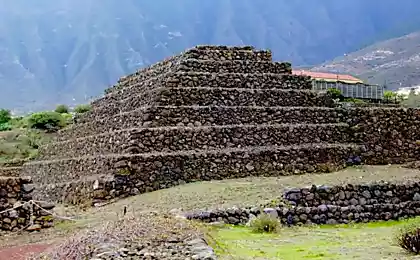1355
Technology 5000 years ago (10 photos)
Amazing discoveries were found 5,000 years ago.
Impressive is that some products have been processed in such a way as if at the time were lathes and special tools.
In the Cairo Museum, as well as many other museums around the world, there are samples of stone have been found in and around the famous step pyramid at Saqqara, known as the pyramid of Pharaoh Djoser Dynasty III (2667-2648 BC). Egyptian antiquities researcher W. Petrie found fragments of similar products on the Giza plateau.

In respect of these stone objects, there are a number of outstanding issues. The fact that they bear the unmistakable traces of machining - circular grooves left by the cutter at the axial rotation of these items during their production by some mechanisms such as a lathe. On the upper left image, these grooves are particularly well visible near the center of things, where the cutting edge in the final stages of working intensively, also visible grooves left the sudden change in feed angle of the cutting tool. Such visible signs of treatment and basalt bowl in the right picture (the ancient kingdom, kept in the Museum of dish).
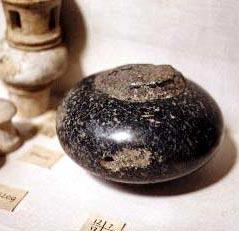
These stone spheres, bowls and vases - not only household utensils of the ancient Egyptians, but also samples of art of the highest ever found by archaeologists. The paradox is that the most impressive exhibits are the earliest period of ancient Egyptian civilization. They are made from a variety of materials - from soft plaster type, up to the "difficult" in terms of hardness, such as granite. Working with soft rock, such as alabaster, compared with the granite is relatively simple. Alabaster can be processed using primitive tools and grinding. Virtuoso same work done in granite, cause a lot of questions today, and show not only a high level of arts and crafts, but, perhaps, a more advanced technology pre-dynastic Egypt.
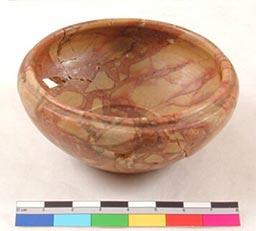
Peter wrote about this: "... Lathe seems to have been as familiar tool in the Fourth Dynasty, as well as in today's factory floor».
In the pictures above: a sphere of granite (Saqqara, III dynasty, Cairo Museum), a bowl of calcite (III dynasty), a vase of calcite (III dynasty, the British Museum).

Stone products like this vase on the left, were made in the very early period of Egyptian history, and later did not occur. The reason is obvious - the old skills have been lost. Some of the vases are made of a very brittle rock types schist (close to silicon), and - the most inexplicable - yet completed, processed and polished to the point where the edge of the vase comes down almost to nothing to the thickness of a sheet of paper - by today's standards it's just extraordinary feat of ancient masters.
Other products carved out of granite, porphyry, basalt, or "full" hollow, while narrow, sometimes very long neck, the presence of which does obscure internal processing vessel provided hand-made (to the right).
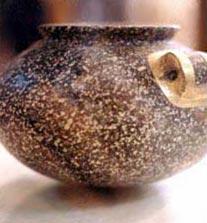
The lower part of the granite vases treated with such precision that the entire bowl (about 23 cm in diameter, hollow inside and with a narrow neck), being placed on the glass surface, takes after swinging completely vertical position of the center line. The area of contact with the surface of the glass is no more than chicken eggs. A necessary condition for such a fine balancing - a hollow stone ball must be perfectly smooth, uniform wall thickness (at such a tiny footprint - less than 3, 8 mm2 - any asymmetry in such a dense material like granite, would have led to the rejection of vases from the vertical axis).
Such technological delights can lead to the astonishment today any manufacturer. Nowadays perform a similar product, even in a ceramic version is very difficult. The granite - is virtually impossible.
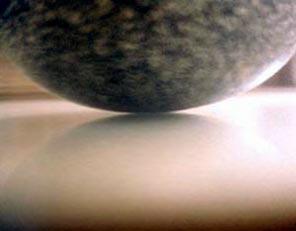

In the Cairo museum exhibits quite large (60 cm in diameter or more) of the original product slate. It resembles a large vase with a cylindrical center of 5-7 cm in diameter, with a thin outer rim and three plates, evenly spaced around the perimeter and curved toward the center "vase." It is an ancient sample of surprising skill.
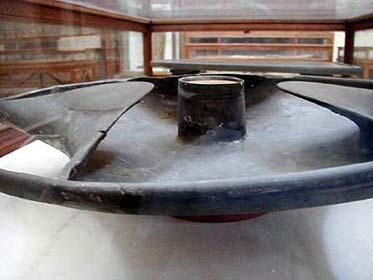

These pictures show only four samples of the thousands of objects found in and around the step pyramid at Saqqara (the so-called pyramid of Djoser), which is now believed to be the oldest stone pyramid in Egypt. It is - first of all constructed, which has no comparable analogues and precursors. Pyramid and its surroundings - a unique place in the number of found samples of art and household utensils made of stone, although fragments of similar products Egyptian researcher William Peter was in the area of the Giza plateau.
Many of the findings of Saqqara are scratched on the surface of the characters with the names of the rulers of the earliest period of Egyptian history - from the pre-dynastic kings before the first pharaohs. Judging by the letter of the primitive, it is difficult to imagine that these inscriptions were made by the same artisan virtuoso that created these exquisite designs. Most likely, this "graffiti" were added later by people who somehow proved their subsequent owner.
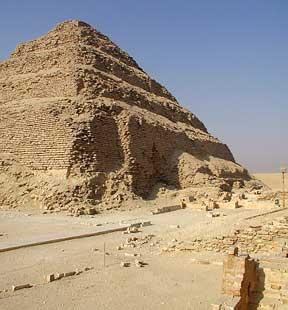
So who are they manufactured? And how? And where? And when? And what events took place with those people whose household utensils were buried in the oldest of the Egyptian pyramids?
Source: www.goldentime.ru
Impressive is that some products have been processed in such a way as if at the time were lathes and special tools.
In the Cairo Museum, as well as many other museums around the world, there are samples of stone have been found in and around the famous step pyramid at Saqqara, known as the pyramid of Pharaoh Djoser Dynasty III (2667-2648 BC). Egyptian antiquities researcher W. Petrie found fragments of similar products on the Giza plateau.

In respect of these stone objects, there are a number of outstanding issues. The fact that they bear the unmistakable traces of machining - circular grooves left by the cutter at the axial rotation of these items during their production by some mechanisms such as a lathe. On the upper left image, these grooves are particularly well visible near the center of things, where the cutting edge in the final stages of working intensively, also visible grooves left the sudden change in feed angle of the cutting tool. Such visible signs of treatment and basalt bowl in the right picture (the ancient kingdom, kept in the Museum of dish).

These stone spheres, bowls and vases - not only household utensils of the ancient Egyptians, but also samples of art of the highest ever found by archaeologists. The paradox is that the most impressive exhibits are the earliest period of ancient Egyptian civilization. They are made from a variety of materials - from soft plaster type, up to the "difficult" in terms of hardness, such as granite. Working with soft rock, such as alabaster, compared with the granite is relatively simple. Alabaster can be processed using primitive tools and grinding. Virtuoso same work done in granite, cause a lot of questions today, and show not only a high level of arts and crafts, but, perhaps, a more advanced technology pre-dynastic Egypt.

Peter wrote about this: "... Lathe seems to have been as familiar tool in the Fourth Dynasty, as well as in today's factory floor».
In the pictures above: a sphere of granite (Saqqara, III dynasty, Cairo Museum), a bowl of calcite (III dynasty), a vase of calcite (III dynasty, the British Museum).

Stone products like this vase on the left, were made in the very early period of Egyptian history, and later did not occur. The reason is obvious - the old skills have been lost. Some of the vases are made of a very brittle rock types schist (close to silicon), and - the most inexplicable - yet completed, processed and polished to the point where the edge of the vase comes down almost to nothing to the thickness of a sheet of paper - by today's standards it's just extraordinary feat of ancient masters.
Other products carved out of granite, porphyry, basalt, or "full" hollow, while narrow, sometimes very long neck, the presence of which does obscure internal processing vessel provided hand-made (to the right).

The lower part of the granite vases treated with such precision that the entire bowl (about 23 cm in diameter, hollow inside and with a narrow neck), being placed on the glass surface, takes after swinging completely vertical position of the center line. The area of contact with the surface of the glass is no more than chicken eggs. A necessary condition for such a fine balancing - a hollow stone ball must be perfectly smooth, uniform wall thickness (at such a tiny footprint - less than 3, 8 mm2 - any asymmetry in such a dense material like granite, would have led to the rejection of vases from the vertical axis).
Such technological delights can lead to the astonishment today any manufacturer. Nowadays perform a similar product, even in a ceramic version is very difficult. The granite - is virtually impossible.


In the Cairo museum exhibits quite large (60 cm in diameter or more) of the original product slate. It resembles a large vase with a cylindrical center of 5-7 cm in diameter, with a thin outer rim and three plates, evenly spaced around the perimeter and curved toward the center "vase." It is an ancient sample of surprising skill.


These pictures show only four samples of the thousands of objects found in and around the step pyramid at Saqqara (the so-called pyramid of Djoser), which is now believed to be the oldest stone pyramid in Egypt. It is - first of all constructed, which has no comparable analogues and precursors. Pyramid and its surroundings - a unique place in the number of found samples of art and household utensils made of stone, although fragments of similar products Egyptian researcher William Peter was in the area of the Giza plateau.
Many of the findings of Saqqara are scratched on the surface of the characters with the names of the rulers of the earliest period of Egyptian history - from the pre-dynastic kings before the first pharaohs. Judging by the letter of the primitive, it is difficult to imagine that these inscriptions were made by the same artisan virtuoso that created these exquisite designs. Most likely, this "graffiti" were added later by people who somehow proved their subsequent owner.

So who are they manufactured? And how? And where? And when? And what events took place with those people whose household utensils were buried in the oldest of the Egyptian pyramids?
Source: www.goldentime.ru
